California’s largest ever fire was a force that could not be stopped
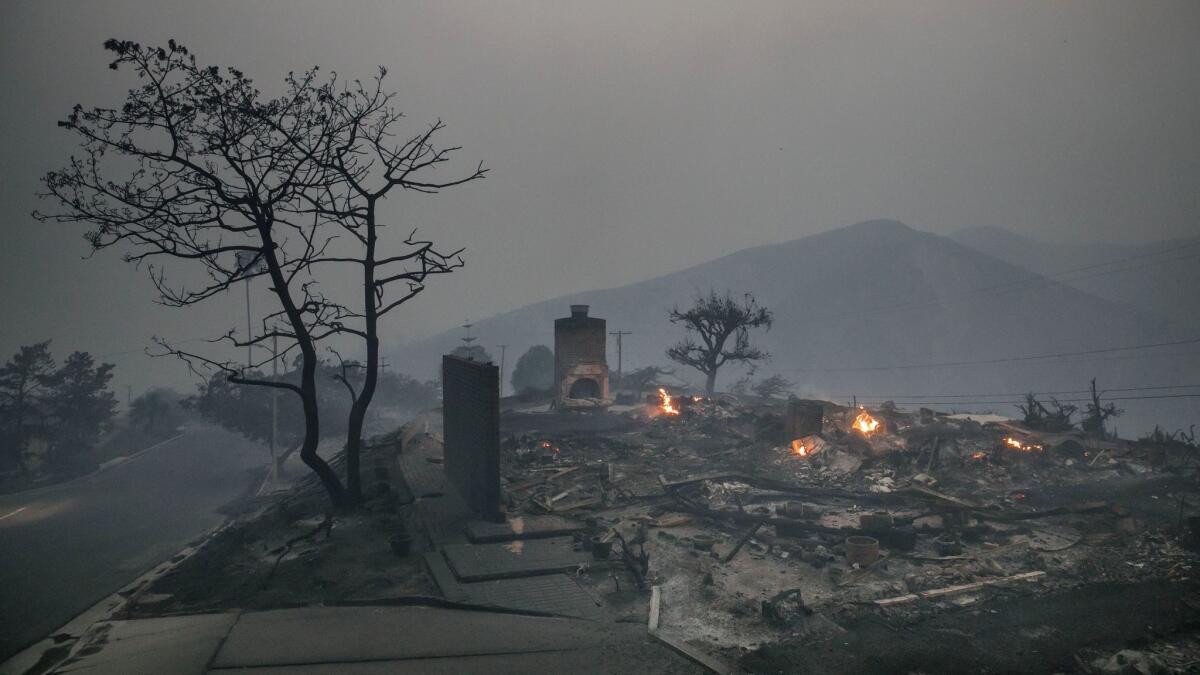
Reporting from Ventura — The fire left the mountains ghostly gray, vast slopes frozen still but for dust devils wandering the ash.
Fire crews were conducting a last big operation in the high country, burning a ridge above Hartman Ranch to keep the main fire from mushrooming into a road-less wilderness where condors soar.
The Thomas fire had already torn through disparate points of Southern California — beach enclaves, orange groves, rural canyons, golf retreats and suburban cul-de-sacs. Flames ignited fan palms against the Pacific surf and cedars on high granite peaks.
Residents along the flame front had seen fires come out of the mountains many times before — at horse ranches in Ojai, at farmworker camps in Fillmore, at Tuscan estates in stands of olive trees in Montecito.
But never had they all been threatened by a single fire.
The Thomas fire became California’s largest by size since modern recordkeeping began, standing at over 281,900 acres as of Friday. It raced from the urban edge to deep into the Los Padres National Forest like no fire before it, covering huge distances unobstructed and mostly unseen. The neighborhoods and cities that sit at the foot of these steep ranges — the Santa Ynez, Topatopa, Sierra Madre — had no vantage to the immense wilderness beyond the first ridge or two, no real grasp of what was seething out of sight.
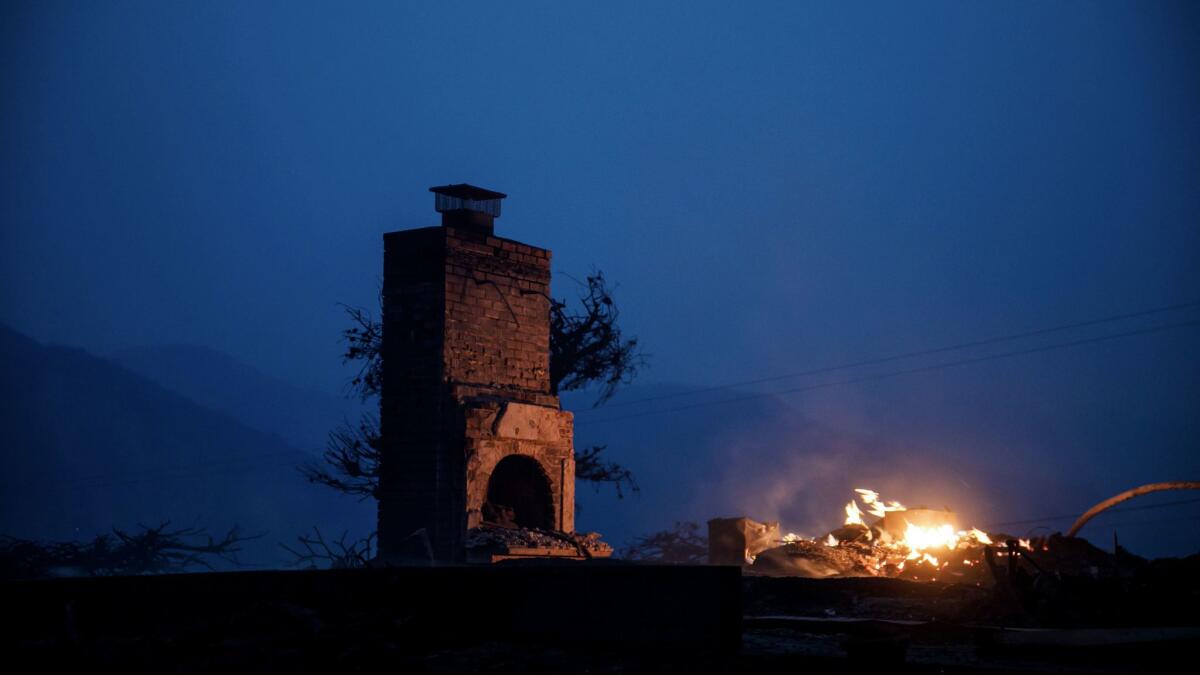
When the fire came over those ridges again and again, to eat homes across a 55-mile swath of civilization, they had to confront that buried seed of doom that Californians forever try to forget: We settled in a dangerously temperamental land.
While we have fought to subdue its mood swings with human ingenuity — canals, levies, dams, injection wells, seismic retrofits, debris basins, brush clearance, tile roofs, hotshot crews, air drops — our efforts are feeble compared to what has and will come.
At the beginning of the year, following a devastating five years of drought, California was having the wettest rainy season ever recorded. The spillways of the mighty Oroville Dam were failing, part of the Central Valley had become an inland sea, and a quarter-mile stretch of Highway 1 was about to fall into the Pacific.
“We broke the drought with a sledgehammer,” said Jeffrey Mount, a hydrologist and senior fellow at the Public Policy Institute of California.
But just enough precipitation came as snow, with the storms spaced out over the season, to avoid a major calamity. “By all objective measures, we should have had catastrophic flooding,” Mount said. “We would be talking billions of dollars of damage and how many people died.”
A long scorching summer followed. In June, Death Valley hit 127 degrees, seven degrees shy of the hottest temperature recorded on earth. The melting snowpack caused flooding in the arid valleys below.
Under a sun that didn’t relent from spring through fall, grass and brush withered.
By October, the wine country erupted in the most destructive firestorm in state history, killing 44 people and claiming over 10,000 homes. Rains stayed far to the north. A high-pressure ridge formed like the one that started the drought in 2011, making this December one of the driest on record.
And so came the Thomas fire, primed to break another record.
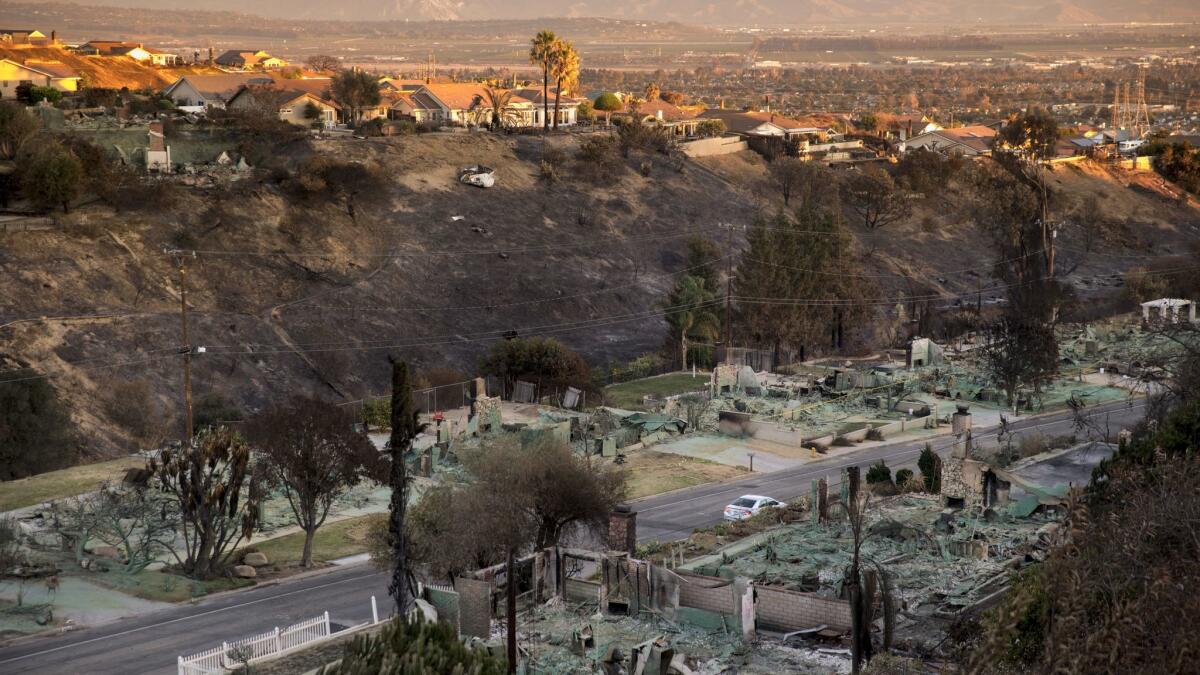
When a high-pressure whorl moves east across Nevada and Utah, Santa Ana winds flow from the high desert to the ocean through three main grooves: the Banning Pass from the Coachella Valley, the Cajon Pass from the Victorville area and the Santa Clara River from the Antelope Valley.
In December, that swirling high-pressure dome stalled and wobbled in place. Bill Patzert, climatologist for NASA’s Jet Propulsion Laboratory, likened it to Hurricane Harvey parking over Houston, swamping the city with days of torrential rains.
In Ventura County, the Santa Clara River Valley became a katabatic wind tunnel for two weeks. The spinning blob of pressure, shifting back and forth, changed the direction of the air flow as it fought with the prevailing sea breeze, constantly pushing the fire into new territory.
What was previously California’s largest modern-era blaze, the Cedar fire in San Diego County in 2003, followed a more typical Santa Ana pattern, racing to the coast through canyons running roughly westward.
It was far more deadly and costly than the Thomas because the gentle tilt of San Diego County invited more development into the fire zone. The Cedar’s toll was 15 people and 2,820 structures.
The Thomas fire has claimed 1,063 structures and one firefighter’s life. The terrain it consumed is more rugged, most of it protected or prohibitively steep to build on.
The population center hit the hardest, Ventura, was on the low edge of the foothills — vulnerable, but easy to evacuate. Homes that burned were less than a mile from the relative safety of the flat Santa Clara River Valley and the coast. No one died there.
Among the streets worst hit: Via Ondulando, a typical postwar street of ranch and Spanish homes, diamond grid windows, lush front lawns, birds of paradise, baby blue plumbago, Italian cypress.
Raul Gamino, a retired car salesman, had lived on the street for 42 years and used to hike in the hills above his home with his grandchildren. But he never gave much thought to how those dry-grass hills connected to the mountains beyond, how fire from far away could whip across it in his sleep. He never imagined a fire that would cover 440 square miles, as the Thomas would. His thoughts generally followed the view, the green coastal plain to Point Mugu and the Pacific.
Over the years, Gamino, 75, had watched countless hours of news reports on flames in Montecito or Santa Barbara. Those disasters seemed distant to him, way up the coast, the way a Lawndale or Culver City resident might watch a blaze in Malibu. He could smell the smoke, ponder the ash and the strange orange light. But they lived in fire country; he did not, he thought.
On Dec. 4, when a friend told him fire was burning up the valley in Santa Paula, he said, “Ah, it never gets here. It never happened before. I’ve been in Ventura for 53 years.”
That night, embers machine-gunned southwest down a boot heel of eroded ravines known as Sulphur Mountain.
As the sky lit up orange, he and his wife Yolanda fled with just a pillow and blankets. They slept in their SUV in a Walmart parking lot.
The fire followed the hills to the heart of downtown Ventura, burning right up to the back of City Hall, before that finger was stopped by flatter terrain and firefighting.
The Gaminos drove back up their hill three days later. In spots, the gutters had become adorned by the braided sculptures of melted alloy rims, wildfire’s ubiquitous signature on the urban edge.
Of 63 homes on the street, 32 burned to the ground. The Gaminos’ yellow stucco-and-tile house survived, as if nothing had happened at all. The lawn was still green. Their king palms luffed in the breeze. Yolanda cried out of relief and sadness and pure shock. He was calm, a perpetual optimist.
Their neighbor across the street, Debbie, a retired teacher who was giving Yolanda English lessons, lost her home. Only the book exchange box on the curb survived.
She and Raul had moved in the same year. They had both lost spouses to cancer. The death of Gamino’s first wife taught him that property didn’t mean much.
“The only thing that is important is your life. We worry too much about property,” he said.
But the scope of personal loss on a street like this is as hard to fathom as is the scale of the fire itself.
On Via Ondulando, you can see hints of it.
Debbie’s book box.
The old meticulously kept Rambler with whitewall tires, scorched in a driveway.
The silence of a ruined home but for the handmade tin windmills still clanging and spinning in the wind. The melted children’s swings.
The bowls of dog and cat food left in the driveway out of desperation.
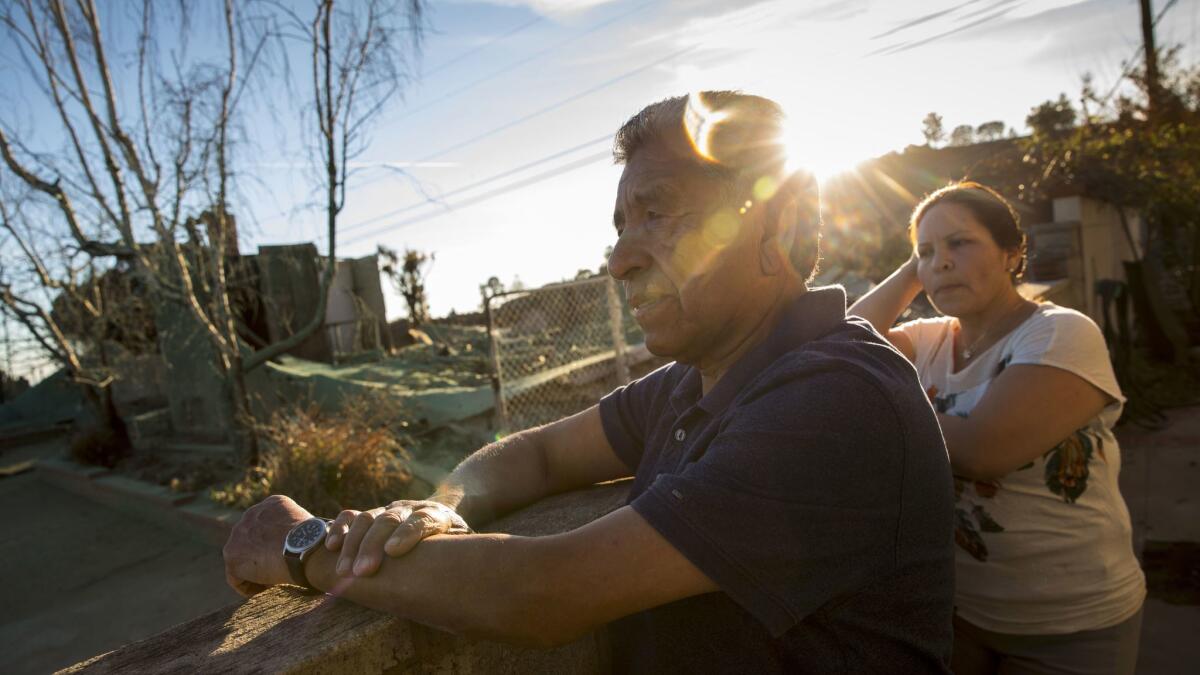
By the time the Gaminos returned, the wind had turned northwest and pushed the fire deep into the mountains, at times shifting to the north and northeast. The air parched throats and cracked lips and chapped the chaparral that already hadn’t had water for nearly 10 months.
“The constant was the dryness,” said Patzert, the climatologist.
The most worrisome finger of the conflagration crawled west along the Santa Ynez into the territory of another fearsome downslope wind, the local sundowner, which hits just after sunset as interior temperatures in the valleys drop fast. For over a week, crews bulldozed and hand-cut lines along the ridge to keep the sundowners from driving the fire straight into Montecito, to limited success.
Now the fire’s prolonged tour came to some of the wealthiest real estate in the world, dragging castle owners into the collective experience of modest suburbanites, avocado growers, beach shack dwellers, crop pickers and back-to-the-landers.
On Dec. 20, strong sundowners were predicted, this time threatening Santa Barbara.
On Via Ondulando in Ventura, the fire had passed and the Gaminos went about their routine — drove to the local L.A. Fitness for a Zumba class, raked the avocado leaves in the side yard. But their street was a ruin.
On East Camino Cielo, 3,600 feet above Santa Barbara, fire crews shored up lines on the ridge. The fire was skunking now, as they say, smoldering in the fallen leaf duff. It needed a hard wind to bring it back up to flame.
But as the sun sank over San Miguel Island, the wind rustled up only a few heavy gusts — the last gasps of the Thomas, as far as the threat to humans and property went.
Deep in the Los Padres National Forest, the fight was to protect the wilderness now. Firefighters had driven an hour up Highway 33 from Ojai, through a landscape so charred that only the raw rock along road cuts showed color, an almost incandescent yellow against the gray.
At the Hartman Ranch, they were trying to create a space void of fuel to keep the fire from running north into thick vegetation, then spreading east into the Sespe Wilderness or west into the footprint of the Zaca fire, which burned 240,000 acres in 2007. No one was quite sure if the chaparral there had grown back enough to burn again. And if it burned twice in such short succession, would it ever recover?
Such were the questions of the new fire era.
All the top five wildfires in California by size have occurred since 2003. It is a cliche by now for commanders at every big fire to say they have never seen “anything like this.”
But Kevin Chargois, an engine captain from San Bernardino National Forest overseeing the back-burn, had to deal with conditions he says he honestly never encountered during regular fire seasons. For one, at 4,500 feet in December, his hoses and valves kept freezing at night. The crews had to wait for them to thaw in the morning to use.
“Here we are, a few days before Christmas, 16 days of fire, and 15 have been red-flag warnings for Santa Anas,” he said.
As he spoke the air was getting moist, and the backfire was not taking off like they wanted it to.
They brought out a flame-throwing terra torch to blaze it up. But the weather kept getting colder and more humid — bad for their backfire effort, but good to dampen the main fire.
Their prescribed burn was petering out. An onshore wind picked up.
Suddenly, they were quickly packing up the trucks to get out while they could.
It was snowing.
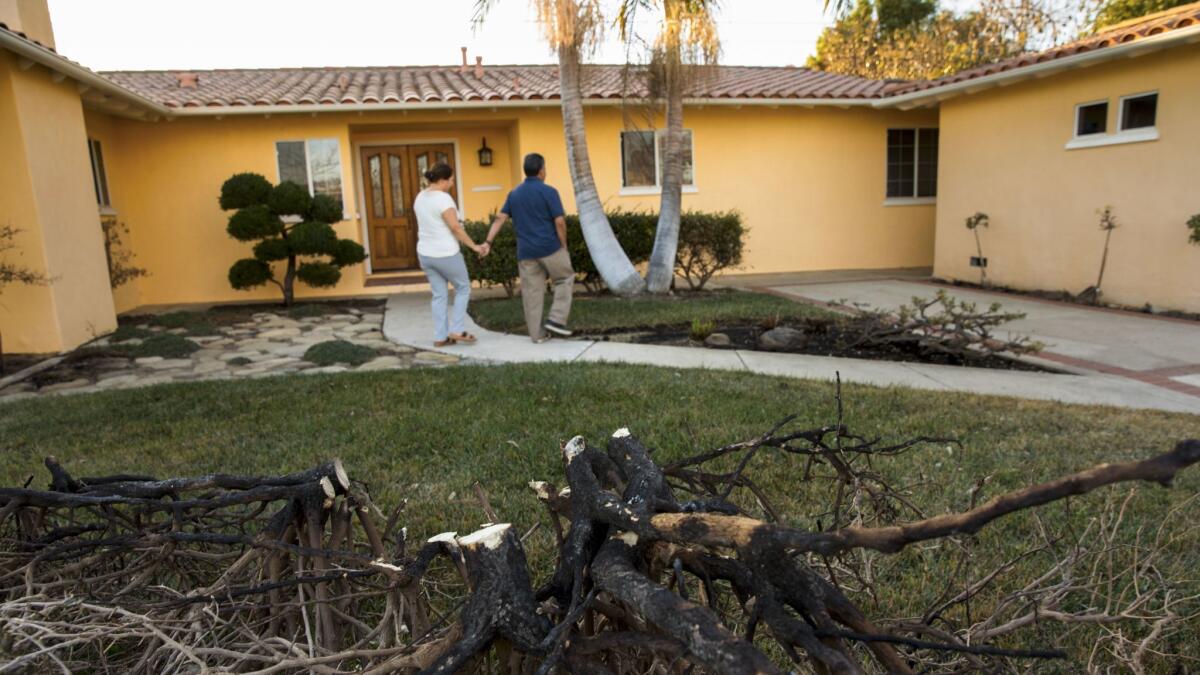
More to Read
Sign up for Essential California
The most important California stories and recommendations in your inbox every morning.
You may occasionally receive promotional content from the Los Angeles Times.











